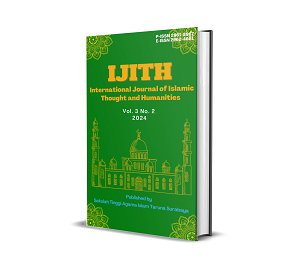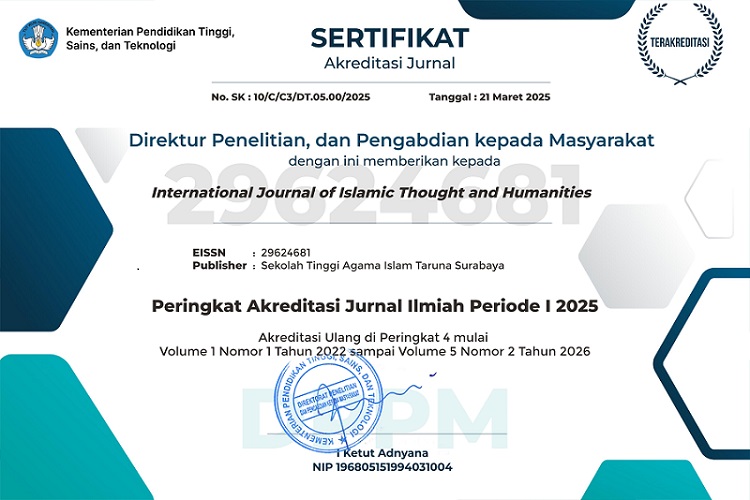Classroom Management Strategies in Fiqh Learning on the Material of Obligatory Prayers at MI An Nur Krian Sidoarjo
DOI:
https://doi.org/10.54298/ijith.v3i2.565Keywords:
Classroom Management, Fiqh, Obligatory Prayer, Islamic EducationAbstract
This study aims to describe the classroom management strategies applied in Islamic Jurisprudence (Fiqh) learning, specifically the material of Fardhu Prayer for second grade students at Madrasah Ibtidaiyah (MI) An Nur Krian. The background of this study emphasizes the importance of Islamic Jurisprudence learning that is not only theoretical but also includes practical, affective, and spiritual approaches, which are specifically adapted to the developmental characteristics of children of Madrasah Ibtidaiyah age. A qualitative descriptive method was used with data collection techniques of observation, interviews, and documentation. The results of the study show five main strategies used by teachers: (1) learning planning based on direct prayer practice, (2) classroom arrangement resembling rows, (3) use of visual media such as motion cards and learning videos, (4) reinforcement of positive behavior through rewards and praise, and (5) an affective and spiritual approach in which the teacher acts as a role model. These strategies effectively create a conducive classroom atmosphere, increase student engagement, and foster internalization of sincerity in worship. This study confirms that appropriate classroom management in Islamic Jurisprudence learning has a significant influence on the success of value-based religious education in early childhood. These findings can be a reference in developing a fiqh learning model based on character formation and practical experience in Islamic elementary schools.
Downloads
References
Abdullah, R. (2019). The role of Islamic rituals in moral education of children. Journal of Moral Education, 48(2), 223–236. https://doi.org/10.1080/03057240.2019.1605703
Çelik, H., & Arikan, Y. (2021). Classroom management strategies among novice and experienced teachers: A comparative study. International Journal of Instruction, 14(1), 137–152. https://doi.org/10.29333/iji.2021.1419a
Creswell, J. W. (2016). Research design: Qualitative, quantitative, and mixed methods approaches (4th ed.). SAGE Publications.
Hasan Ruzakki, & Hosaini. (2021). Pengembangan Pembelajaran Fiqih Dengan Model Cooperative Learning Kelas Iii Madrasah Ibtidaiyah Salafiyah Syafi’Iyah Sukerejo. JOEL: Journal of Educational and Language Research, 1(2), 175–192. https://doi.org/10.53625/joel.v1i2.445
Hasanah, U., & Yusuf, A. (2021). Pengelolaan kelas humanis di lingkungan madrasah. Jurnal Pendidikan Karakter, 11(1), 67–78. https://doi.org/10.21831/jpk.v11i1.36566
Izzaty, R. E., & Pohan, S. (2020). Penggunaan media visual dalam pembelajaran ibadah untuk anak SD. Jurnal Teknologi Pendidikan, 22(3), 245–256. https://doi.org/10.21009/jtp.v22i3.18002
Mahmud, M. (2022). Pembelajaran fikih berbasis praktik di Madrasah Ibtidaiyah. Jurnal Edukasi Islam, 6(1), 45–56.
Mayzy Az-Zahra Putri, I., Nuqia, K., & Baktiarso, S. (2025). Strategi Manajemen Kelas yang Efektif dalam Meningkatkan Kualitas Pembelajaran Siswa dan Menciptakan Lingkungan Belajar yang Kondusif di Sekolah. Jurnal Ilmu Pendidikan Publish By Era Digital Nusantara Izzah Mayzy Az-Zahra Putri, Khuzaifah Nuqia, Singgih Baktiarso, 1(3), 77–81.
Miles, M. B., Huberman, A. M., & Saldaña, J. (2014). Qualitative data analysis: A methods sourcebook (3rd ed.). SAGE Publications.
Moleong, L. J. (2018). Metodologi penelitian kualitatif. Remaja Rosdakarya.
Nur, R. A. (2023). Pembentukan Karakter Religius Siswa Kelas II Madrasah Ibtidaiyah Muhammadiyah Program Khusus 1 Sukoharjo Tahun Pelajaran 2022 / 2023. 9, 167–178.
Nurdin, E. (2020). Character-based learning in Islamic elementary schools. Indonesian Journal of Islamic Education, 4(1), 25–36. https://doi.org/10.20414/ijie.v4i1.2897
Rahman, T. (2022). Integrating shalat practice in elementary school curriculum: A case study. Journal of Islamic Studies and Education, 10(2), 150–162. https://doi.org/10.52620/jise.v10i2.872
Reizer, A. (2007). The role of teacher emotional support in student engagement. Educational Psychology Review, 19(3), 239–256.
Safitri, Dian dan Nur Fuadi. (2025). Pendahuluan. Dirasa Islamiyya, 4(1), 109–125. https://doi.org/10.63548/dijis.v4i1.53
Sugiyono. (2019). Metode penelitian pendidikan: Pendekatan kuantitatif, kualitatif, dan R&D. Alfabeta.
Susanto, A., Khaerani, H. T., Sandrika, T., Putri, A. S., Maulana, S. Z., & Jahro, S. A. (2025). Inovasi Penataan Ruang Kelas Untuk Meningkatkan Keterlibatan Siswa Dalam Proses Pembelajaran. AT-TAKLIM : Jurnal Pendidikan Multidisiplin, 2(6), 39–53. https://journal.hasbaedukasi.co.id/index.php/at-taklimHalaman:39-53
Yunita, M. I., Iswandayani, H., April, N. D. R., Anggraini, F. W., Azkiyah, S. R., & Susanto, B. H. (2024). Analisis Implementasi Pengelolaan Kelas Dan Pengelolaan Peserta Didik. Journal Innovation in Education, 2.
Zahroh, N., & Choiriyah, L. (2021). Strategi guru dalam meningkatkan motivasi belajar fikih.
Downloads
Published
How to Cite
Issue
Section
License
Copyright (c) 2024 Kusnul Munfa'ati, Sinta Wahyuningsih A., Siti Zumaro

This work is licensed under a Creative Commons Attribution-ShareAlike 4.0 International License.
Authors who publish with this journal agree to the following terms:
- Authors retain copyright and grant the journal right of first publication with the work simultaneously licensed under a Creative Commons Attribution-ShareAlike 4.0 that allows others to share the work with an acknowledgement of the work's authorship and initial publication in this journal.
- Authors are able to enter into separate, additional contractual arrangements for the non-exclusive distribution of the journal's published version of the work (e.g., post it to an institutional repository or publish it in a book), with an acknowledgement of its initial publication in this journal.
- Authors are permitted and encouraged to post their work online (e.g., in institutional repositories or on their website) prior to and during the submission process, as it can lead to productive exchanges, as well as earlier and greater citation of published work (See The Effect of Open Access).


















